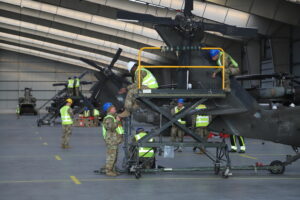
In October the harbour of Vlissingen in the south of The Netherlands got even busier than it normally already is. But instead of with ships, the place is now buzzing with helicopters and vehicles of the United States Army.
The 1st Infantry Division Combat Aviation Brigade or 1 ID CAB of the US Army is deploying to Europe in support of European allies and partners. They will be replacing the 3 ID CAB that is currently in Europe. In 2021 1 ID CAB was on deployment in Europe for the last time. “We have trained diligently over the past year in preparation for our deployment” said Col. Chad Corrigan, the commander of 1 ID CAB. “The Demon Brigade is more than ready to deploy to support this mission and continue to strengthen our established relationships with our European allies.” Already since World War II the United States have had multiple military bases and deployments in Europe.

Since 2014, when the Crimea was annexed by Russia, the number of military units has increased again. This increased presence is part of operation Atlantic Resolve, which provides rotational deployments of combat-credible forces to Europe to show American commitment to NATO while building readiness, increasing interoperability and enhancing the bonds between allies and partner militaries. As part of this a Combat Aviation Brigade is deployed to Europe continuously, rotating every nine months.

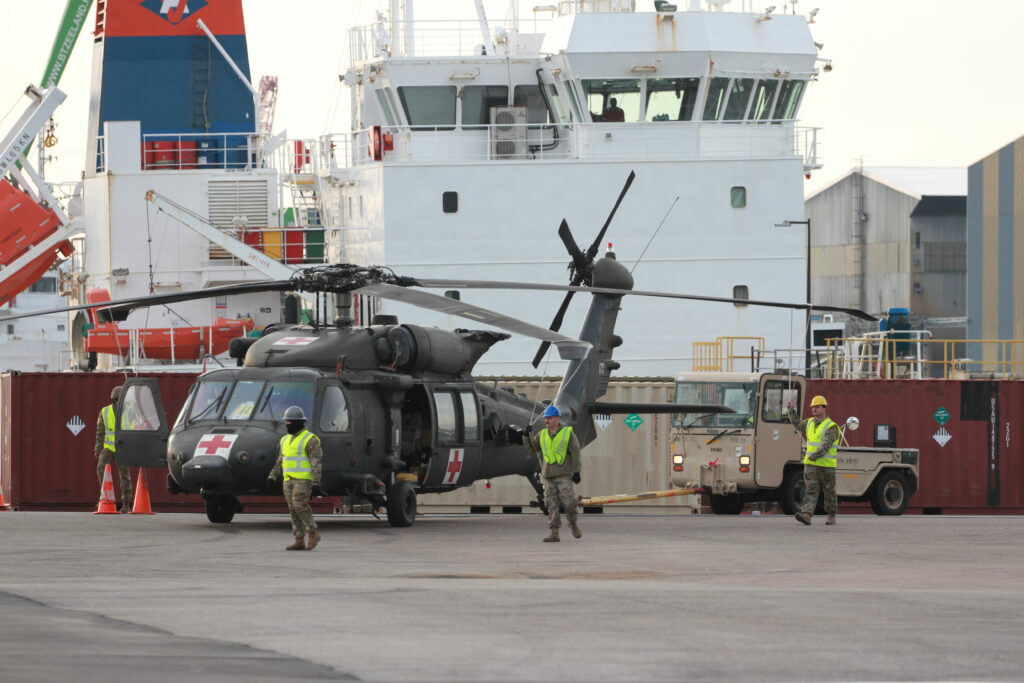
Deploying some 50 helicopters, 1.400 vehicles and shipping containers and supporting personnel is quite an undertaking. And it can’t be done without help from other nations. That’s where Host Nation Support comes into play. All NATO members made a commitment to support other members when they are deploying troops via their country if necessary. This support is called Host Nation Support, which is defined as ‘civil and military assistance rendered in peace, crisis, and war by a Host Nation to Allied forces and NATO organizations which are located on or in transit through the Host Nation’s territory’. During such a transport or a deployment the host country is responsible for the safety and security all the time. But also all logistics are organised by the host nation, like supplying fuel and food, but also locations to stay overnight.
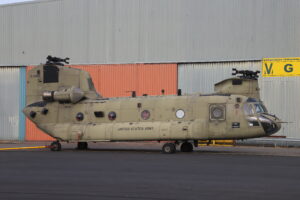
The Netherlands play an important part in military deployments to Europe, acting as ‘gateway to Europe’. This because of its strategic location on the Western coastline, but also because of its good infrastructure and knowledge of logistics. For this Autumns deployment the Dutch formed a team of some 75 people, consisting of both air force and army staff. In charge is Col. Michiel Verlinden: “After we receive a request from the US government, we start coordinating. What gear do you need, what will you bring yourself, what do we supply. We arrange a fitting location, in this case the shipping terminal of Verbrugge.” The whole area is turned into a temporary military establishment, that is secured by the Dutch army.
Sniffer dogs have checked the area for explosives and divers of the Dutch navy did the same under water. The terrain is fenced off and additionally two layers of empty shipping containers restrict the field of view from outside. Both reserve and active duty military guard the terrain day and night. Inside the harbour area the Koninklijke Luchtmacht (Dutch air force) have created an FOB (Forward Operating Base) and they supply the necessary services for the aviation part: a fire crew, a Mobile Air Operations Team (MOAT), a flight safety officer and a meteorological officer.


The 1 ID CAB normally flies from Marshall Army Airfield in Kansas, in the heart of the USA. Their helicopters were flown the 1.200 km to Beaumont in Texas where they were prepared for a sea journey. The vehicles and all other equipment were moved there by train. Transport to Europe went by ship, on the American Roll-On Roll-Off Carrier (ARC) Endurance. This enormous ship has some 25.000 m2 usable floor surface divided over 12 decks, of which some 7 are used during this trip. All the staff that is necessary for the unloading of the cargo and the preparation for flight of the helicopters, in total some 300 men and women, were flown by commercial airline to Eindhoven airbase and from there transported by bus to Vlissingen. Responsible for the American part of the preparations is the US Army Military Surface Deployment and Distribution Command (SDDC). In the USA this was done by the 597th Transport Command while on the European side this is done by the 598th Transport Command, both part of the SDDC.
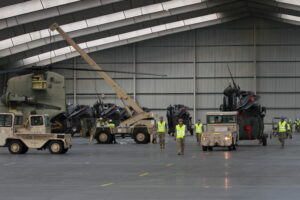
Unloading the ship took some 5 days, working 24/7, and the first helicopter took off from the harbour within 36 hours after arrival. In total 27 H-60 Black Hawks of different subtypes, 16 AH-64E Apaches and 6 CH-47F Chinooks have arrived in Vlissingen. Next to these, another batch of some 30 helicopters followed another route into Europe via a Greek harbour. In Vlissingen harbour no fuel is supplied due to environmental risks. The helicopters are ferried during regular working hours to nearby Woensdrecht airbase, that is designated an Intermediate Support Base (ISB) for the operation, by a few dedicated ferry crews.
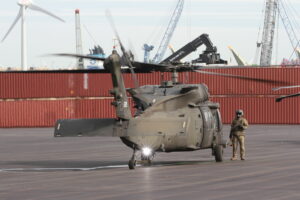
There they are all fuelled up and checked again and if necessary repairs are done by US maintenance crews with Dutch support. When ready, their own crews pick the helicopters up and fly them first to Illesheim in Germany and then forward to their temporary homes in Germany, Poland or Latvia. The other vehicles and equipment continue their journey from Vlissingen by road, mostly on low loaders. This is also done on a 24/7 basis, but is limited by the German law that forbids heavy transport by road on Sundays. Only when the helicopters and vehicles have crossed the German border, the Dutch responsibility for their safety and security ends.
UH-60M Black Hawk copilot Jerome explained they have specifically trained for the circumstances here in the harbour. “At home we followed academic lessons with senior aviators. These consisted of rehearsals with terrain modes assisted with iPads. The take-off will be performed through a high hover and during take-off several high obstacles will be avoided.” The deployment will last for nine months and Jerome sees it as a great way to discover and travel through Europe, while reaffirming NATO presence in Eastern Europe.
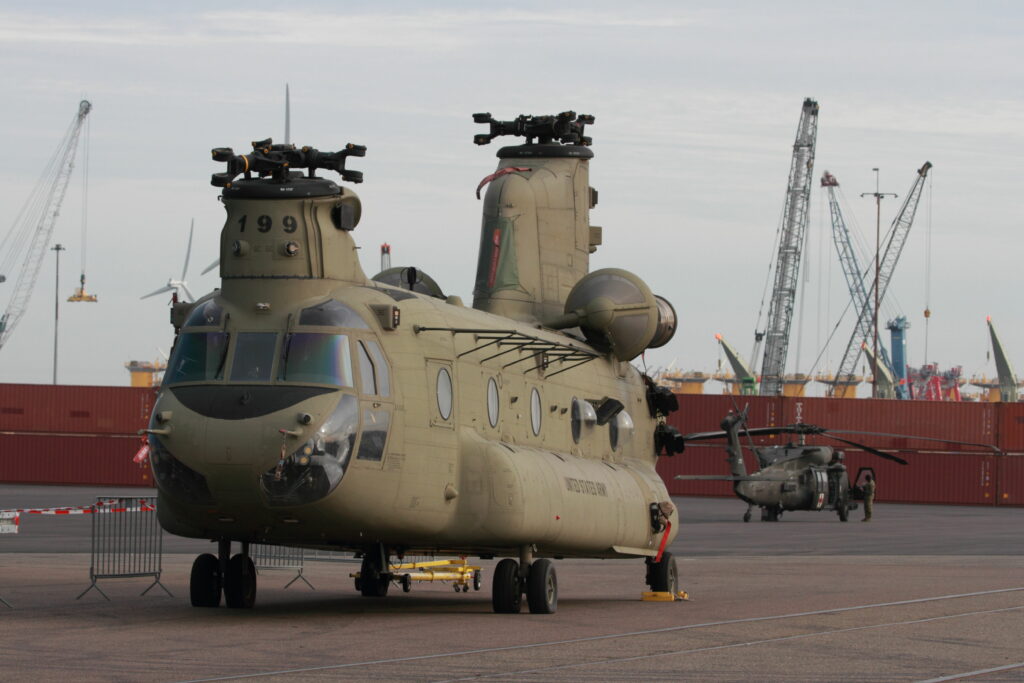

When the 1 ID CAB have left Vlissingen and have reached their temporary homes, the 3 ID CAB will start their journey in the opposite direction, bringing some 55 helicopters to Vlissingen and further towards their homebase in Savannah, Georgia.

One could wonder why they don’t leave all equipment behind and just rotate the personnel after a deployment. But this has a simple operational reason: it is a way of practising and also testing relocating large amounts of troops and equipment, this to be prepared would that be necessary one day. Therefor in the past different harbours have been used, and onward transport has been done via the road, by train and over water as well.
But make no mistake, despite this training effect, the Americans and the Dutch consider this whole deployment an operation, not an exercise. And one that could not be done without Host Nation Support.

